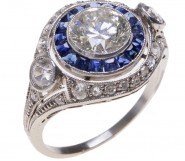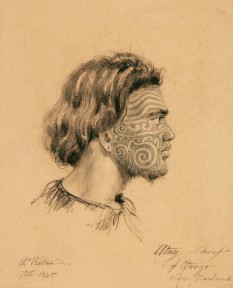Lot #48 - Charles Rodius
-
Auction House:Mossgreen-Webb's
-
Sale Name:Important Paintings & Contemporary Art
-
Sale Date:29 Nov 2017 ~ 6.30pm (New Zealand Daylight Time)
-
Lot #:48
-
Lot Description:Charles Rodius
Atay Chief of Otargo (sic), New Zealand
charcoal, graphite and watercolour on paper, 1835
205mm x 105mm
signed C Rodius and dated Feb 1835 in graphite lower left, inscribed Atay Chief of Otargo New Zealand in graphite lower right -
Provenance:Private collection. Passed by descent to the present owner.
-
Notes:ESSAY: Among a folio of 18 portrait drawings by Charles Rodius (1802–60) in the British Museum, mainly of indigenous Australians, there are a few life drawings of Māori sitters from Sydney in 1834. The present work is a more finished and powerful version of one of these. Rodius was a German-born artist, who studied in Paris where he acquired considerable skill as a portraitist. He was transported to New South Wales in 1829 for the alleged theft of some trifling items from a lady’s handbag while she attended the opera in London. They included a perfume bottle and a pair of opera glasses. In Sydney, Rodius’ skills as an artist and teacher made him useful to the Department of Public Works and gained him a ticket of exemption in 1832 so that he could practise his art, provided he did not leave Sydney. He then could make a living drawing and painting portraits and other subjects of interest in the colony; these works could be readily sold to settlers in Australia or buyers back in London. Among them were his drawings of Aboriginals and also of Māori, who came to New South Wales in some numbers in the 1830s when there was considerable trade and travel between New Zealand and Sydney. The tattoos and dress of Māori were distinctive and gave interest to Rodius’ sketches, which were sometimes reproduced by lithography. In the years before photography, such works were the only means of conveying a picture of the singular appearance of the varied and exotic people thronging Sydney’s wharves and streets. Rodius chose his own subjects, whom he depicted with ‘extraordinary fidelity’, according to the Sydney Herald. This striking drawing is remarkable because it shows a young Māori chief in the years before the Treaty of Waitangi was signed and before New Zealand became a British colony. In the 1830s, Māori had a reputation in Sydney for savagery and cannibalism. The Sydney Herald of 16 October 1834 reported: “The natives are continuing their depredations upon the European in this part (Otago) of New Zealand”. They were reported to be robbing, shooting and killing Europeans on boats and onshore. Another item states: “Every arrival from New Zealand brings intelligence of the committal of fresh atrocities by the Natives of that country upon the defenceless settlers and traders” (Sydney Herald, 21 August 1834). Rodius’ graphic drawing depicts Atay as neither a noble savage nor a meek subject of the British but a proud, virile and potentially deadly foe. The British Museum version of this drawing is dated 12 December 1834 and the location is given as Sydney; Rodius never visited New Zealand. The present work is dated ‘Febr 1835’. There are some minor differences between the drawings, the most notable being the inclusion of a sketchy indication of a cloak around the neck in this example. However, this could easily have been improvised when this version was made and would not have required a fresh sitting. It is most likely that Rodius copied the earlier version at the later date but gave it more contrast and expression. Rodius’ drawing is remarkable for showing the character of his sitter by the strength of his gaze and the jut of his jaw. The somewhat wild sweep of his hair and the shaggy stubble below his chin, as well as his fixed gaze, suggest passion and energy. He is not a passive subject of purely ethnographic interest. Rodius’ use of sweeps of the crayon gives movement to the hair and a sense of life. At the same time, he has recorded the facial moko with care and respect. We normally see full moko on older sitters and this suggests Atay was an exceptional and fearsome chief. At present, his true identity is unknown and ‘Atay’ may be a phonetic rendering of his name. Rodius’ masterly drawing, which conveys the dignity and self-worth of his sitter, is a rare work that has both high historical and artistic importance. Michael Dunn
-
Estimate:NZ$70,000 - 90,000
-
Realised Price:
-
Category:Art
This Sale has been held and this item is no longer available. Details are provided for information purposes only.










